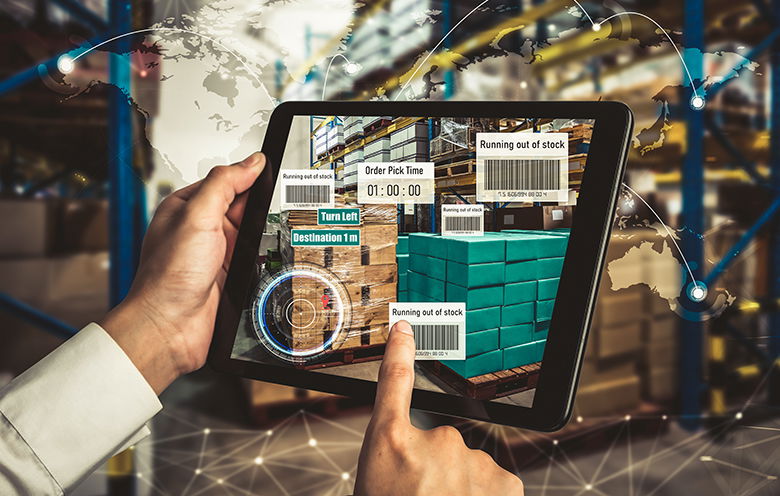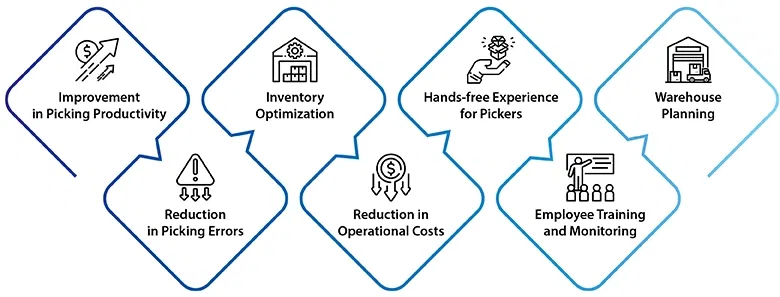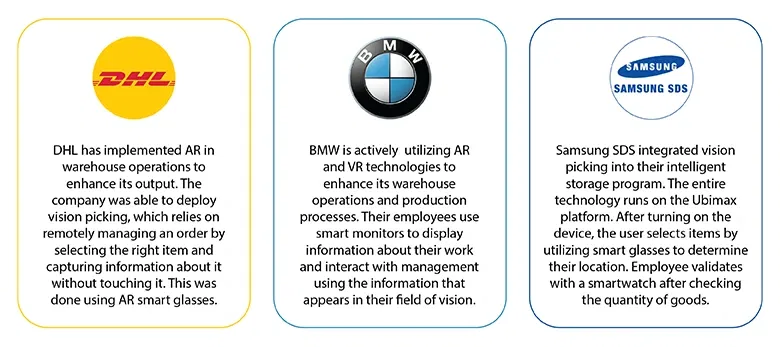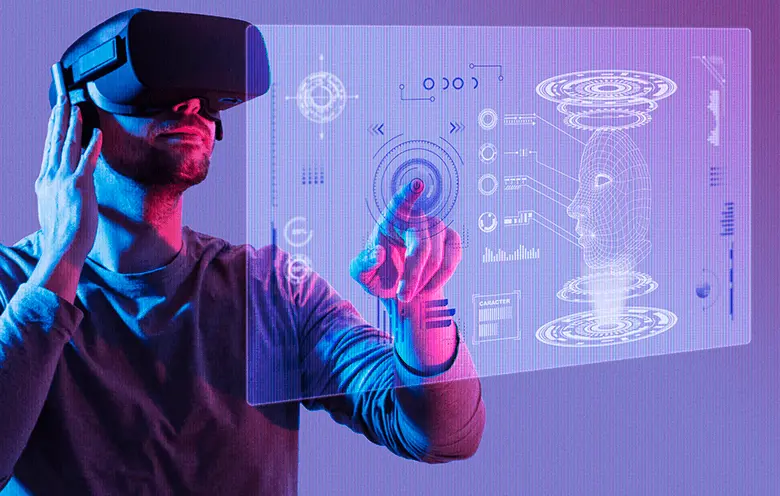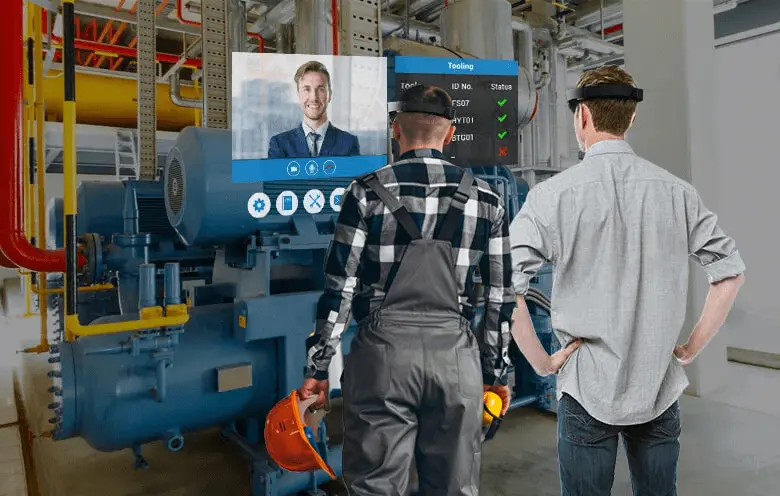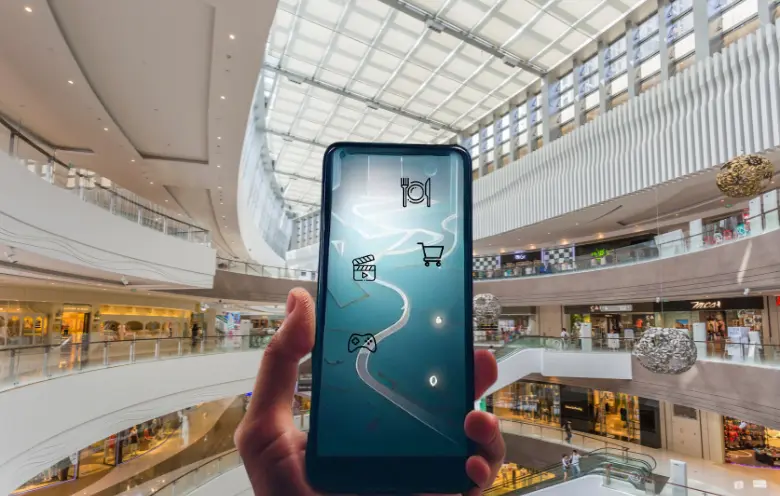Managing a warehouse involves dealing with complex processes that encompass a variety of moving parts: people, equipment, orders and inventory. Most businesses still manage their warehouses using an antiquated approach. Also, due to current management procedures, supervisors have to face a lot of challenges, like:
- Manual processes lead to unnecessary delays
- Orders are consistently put together wrongly
- It takes more effort and money to maintain an obsolete system
- Many returns become difficult to organize
- Labeling errors interrupt work and lead to sluggishness
The implementation of augmented reality (AR) in a warehouse is the most effective solution to handling such issues. It may seem difficult to switch to an automated warehouse system, but it is imperative. Here is where an AR app can help warehouse workers use their smartphones or tablets for accessing real-time information about the items they are handling and their location within the warehouse. It is advisable to take help from an augmented reality app development company because they have the necessary expertise, experience, and resources to create high-quality AR apps that meet your business needs. Also, this will save you time, resources and effort.
Let’s go over the main differences between AR and VR
Augmented reality helps to overlay virtual objects in real-world environments in real time. It enables virtual objects to interact with real-world objects and produce the desired meanings. AR includes video, infographics, photos, sound and other features in an attempt to alter perception.
Though virtual reality (VR) and augmented reality have similar object designs, they achieve two different objectives in two completely different ways. VR moves you away from reality. AR augments reality by overlaying information over what you see in the real-world.
Due to VR’s tendency to fully immerse users, devices restrict their fields of vision to display VR material to completely isolate them from the outside world. For this reason, it is recommended to use special VR gear such as a headset or gloves when exploring VR. Additionally, we can use AR in both 2D and 3D environments just as we do on a smartphone.
Let’s understand how augmented reality works in a warehouse
Implementing AR technology in your warehouse would enable your managers and employees to inspect warehouse layouts easily. They can also determine if adjustments or experiments are possible by donning augmented reality glasses. This is a great resource for gathering data and making judgments about inventory changes and improvements.
It enables logistics companies to schedule and reschedule warehouses, all while spending less time, money and effort. It is like having a communication and mixed reality device that links the digital and real worlds. Using a software that analyses the object, a user can view the relative content of objects in their line of sight.
AR can be used to improve warehouse operations, logistics activities and distribution centers on all fronts. Let’s see how:
1. Warehouse management
A warehouse management system (WMS) is a set of procedures and software programs designed to manage and control warehouse operations like inventory management and picking.
While some businesses employ independent warehouse management systems, others incorporate their WMS into a more comprehensive enterprise resource planning system (ERP). No matter how sophisticated or powerful, every WMS aims to increase the effectiveness of your warehouse operations.
Augmented reality facilitates warehouse management by increasing the efficiency and precision of various data collection procedures. Using barcode scanning systems powered by AR technology on mobile devices, warehouse managers and staff can easily:
- Find products
- Track delivery
- Enhance efficiency
- Streamline procedures
An efficient warehouse management system operation improves customer satisfaction and minimizes backorders and errors.
2. Order picking
Another important process in a warehouse is order picking. Order picking is the process of obtaining the right product in the right quantities and at the proper times as requested by customers.
In the current technology-driven environment, customers need quick delivery of their desired goods and services. Therefore, logistics companies are consistently under pressure to optimize their order-picking processes at the lowest possible price and safeguard their revenue streams.
Previously, employees used to spend a lot of time and effort searching the warehouse for products that matched a customer’s criteria during order picking. This manual process required a lot of work and was prone to mistakes. Then barcode scanners became widely used. This system was not only time-consuming but also unsuccessful because workers had to scan each barcode individually.
AR enhances the accuracy and speed of various data-capturing procedures and leads to efficient warehouse management. It simplifies workflows and makes them more efficient by using barcode scanning solutions based on smart device to find products. An improved WMS operation also results in fewer backorders and errors, thus increasing customer satisfaction.
3. Inventory management
Inventory management is one of the most crucial and challenging aspects of warehouse management. However, the most tedious step that it involves is inventory checking.
Previously, workers had to physically sprint around the warehouse to determine whether inventory needed to be restocked, was prepared to ship, or was in good condition. Traditional stocktaking methods required paperwork and took a lot of time. Moreover, workers had to undergo intense and expensive training to be able to produce the desired job results.
Several big logistics companies invest heavily in barcode scanning devices because manual solutions for inventory management are time-consuming and error-prone.
While these technologies enhance stocktaking procedures and cut down on errors, they are not very flexible and eventually end up costing a lot in hardware. Luckily, barcode scanning systems incorporate augmented reality for inventory management and can optimize your company’s stocktaking methods.
Here are some real-world examples of AR in warehouse management
A few challenges that companies face while implementing AR in their warehouses
1. Cost of implementation
The first and foremost concern is the perceived expense of integrating new technologies. There are different methods for deploying augmented reality; each comes with a distinct cost. In order to create an app from scratch with specific components, you may have to spend a great amount of money. However, the cost of customizing an existing app, will be considerably lower.
For instance, IKEA, a well-known furniture retailer has implemented AR with their mobile sales app. It enables customers to shop on their site. They can also use the AR-powered app to scan their homes with a smartphone to virtually display and preview things before making a purchase.
2. Skill gap
Whenever a new technology is introduced, there are talent and technical disparities along with the concerns that accompany it. However, these concerns can be addressed by providing employees with better training, use cases, implementation guidance and knowledge of maintenance. This can also be resolved by working with an AR solution provider.
Though people also worry about staff skills and generational learning curves, AR technology can be helpful in this area. AR can train staff even remotely which makes businesses more robust to deal with upcoming challenges. You can convert users by front-loading education and demos when you use AR solutions. This will help your workforce understand how augmented reality may improve their bottom line.
3. Lack of resources
It is not easy to find resources with in-depth knowledge and practical experience of augmented reality. Moreover, it takes a lot of time and effort to find new resources and/or train existing ones to cater to your specific business requirements.
The best approach here is to educate your workforce about the capabilities of augmented reality and how they can use it to accomplish their operational goals. This can be achieved with the help of a third-party AR services provider that can train your employees and give them hands-on experience.
4. Management buy-in
Adopting augmented reality requires convincing management, which is one of the biggest challenges. Fortunately, there are now success stories in almost every industry demonstrating enhanced customer experiences and significant increases in staff productivity utilizing AR, as we have discussed above.
In addition, companies that have already implemented AR can address and promote the cost-benefit ratio due to their success throughout the value chain.
5. Cybersecurity and regulatory concerns
Although there is optimism about the potential of augmented reality, some people think that regulations aren’t adequate. They also think that policymakers and AR developers have not taken enough steps to address issues related to accountability, copyright and data privacy. In spite of ethical concerns, governments and businesses are continuously striving to improve technology and solve issues.
How Softweb Solutions helps to address these challenges
With AR in warehouses, the logistics industry can undergo a global transformation. Therefore, many companies have already developed their own AR warehouse management solutions. These technologies make picking processes faster, more user-friendly, less error-prone and more effective.
Although AR warehouse is not fully mature, the results have been impressive. Finally, AR warehouse provides the option to tailor individual solutions to one’s warehouse operations.
We provide a customized solution to help you manage your supply chain and warehouse operations more effectively. We have the expertise to help you utilize augmented reality in logistics. It helps deliver the right products to your customers at the right time through a thorough analysis of your business situation. For more details about AR for warehouse management, please connect with our AR experts now!
